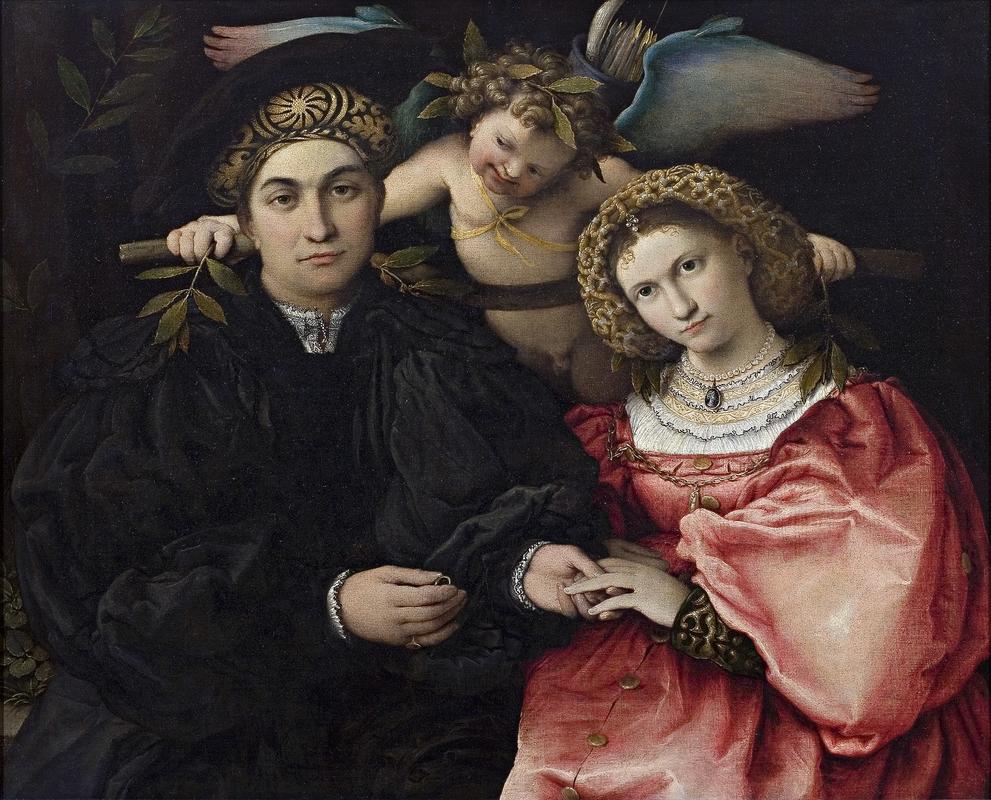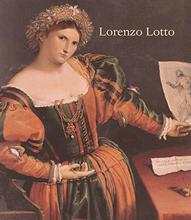More about Marsilio Cassotti and His Wife Faustina
- All
- Info
- Shop

Sr. Contributor
Marsilo Cassotti was getting married rather young when his father commissioned this painting about the “yoke” of marriage from Lorenzo Lotto.
Here’s a romantic metaphor for you: marriage is like a yoke and both have to work together equally to properly pull the plow. What’s more endearing than an allusion to farm animals? That’s the idea of the yoke in the portrait anyway, work together as equals and be happy. Yet, they also make a point of having the wife incline her head to her husband with several other allegories about her “submission to her husband” sprinkled in. Society's idea of “equal” at the time was rather skewed.
Cassotti was marrying up, as in, his wife came from a wealthy family and brought along a big dowry. During this period, dowries weren’t just a blank sum of money but often fine jewels and clothes the bride would wear. So essentially, all the finery that Faustina is wearing in this portrait is likely her dowry and thus her half of the portrait is the sum total of all the possessions and riches Marsilio gains in the marriage. Cassotti had a cousin who listed his consort as his most prized possession on an inventory list, to give you an idea of the out-of-date ideals of the time.
Lorenzo Lotto put a lot of care into the details of Faustina’s jewelry and her fine clothing. He emphasized the time taken in rendering them on his bill, before eventually slashing the cost by a third. He originally wanted to charge 30 ducats, but only charged 20 ducats to Marsilo Cassotti’s father, Zanin Cassotti, after it was finished. The why of that is up for debate. Apparently, Lotto had a habit of underselling his work and charging less than he felt he really should. In the case of this commission, it might have also been due to the imminent death of his patron. Or maybe he was just strapped for cash.
Every piece of Faustina’s jewelry was selected with specific intent. It’s a whole web of allegories about marriage to pick apart, the most interesting among them being the cameo around her neck. Back then, there was a famous Faustina, known as Faustina the Elder, wife of Emperor Antoninus Pius, who ruled Rome around the 1st century AD. This Faustina was celebrated as the perfect wife. After she passed away, her husband declared her divine and built a temple. Her daughter was also named Faustina but the surviving public impression of her was not so kind. The only noticeable difference between the portraits of the mother and daughter is how high their bun is placed on their respective heads. High bun equals perfection personified, lower bun equals scandals and multiple love affairs. The cameo in the portrait is undoubtedly the former, representing the pious 1st century Faustina.
Another thing to note about the many allegories is that there are a lot of callbacks to Ancient Rome, if Cupid wasn’t indication enough. Just like how 1980s nostalgia comes and goes in our age, the people of the Renaissance were big fans of bringing Rome back into fashion.
Sources
- “Annia Galeria Faustina.” Encyclopædia Britannica. Encyclopædia Britannica, inc. Accessed April 13, 2022. https://www.britannica.com/biography/Annia-Galeria-Faustina.
- Brown, Beverly Louise. “The Bride's Jewellery: Lorenzo Lotto's Wedding Portrait of Marsilio & Faustina Cassotti: the Significance of Virtue, Fertility and a Healthy Dowry in 16th-Century North Italian Society Can All Be Read in the Symbolism of a Wedding Portrait by Lorenzo Lotto.” Apollo 169, no. 561 (January 2009).
- Ferraro, Joanne Marie. A Cultural History of Marriage in the Renaissance and Early Modern Age. London, UK: Bloomsbury Academic, 2020.
- “Marsilio Cassotti and His Wife Faustina - The Collection.” Museo Nacional del Prado. Accessed April 13, 2022. https://www.museodelprado.es/en/the-collection/ art-work/marsilio-cassotti-and-his-wife-faustina/799f6e5e-840c-4f33-b9d3-a952874c2293.
- “Portrait of Faustina the Elder (the J. Paul Getty Museum Collection).” Getty. Accessed April 13, 2022. https://www.getty.edu/art/collection/object/103SQC.
- Tsaneva, Maria. Lorenzo Lotto: 110 Paintings. Lulu.com. Lulu.com, 2014.
Featured Content
Here is what Wikipedia says about Portrait of Marsilio Cassotti and His Bride Faustina
Portrait of Marsilio Cassotti and His Bride Faustina is an oil-on-panel painting by Italian Renaissance painter Lorenzo Lotto. The painting was created in 1523, after Lotto had settled down in Bergamo, and is currently housed in the Museo del Prado in Madrid. The work is signed and dated "Lotus Pictor 1523". It is the first known marriage portrait produced in Italy, preceded by earlier such portraits from Germany and the Netherlands, such as the Arnolfini Portrait.
Check out the full Wikipedia article about Portrait of Marsilio Cassotti and His Bride Faustina













